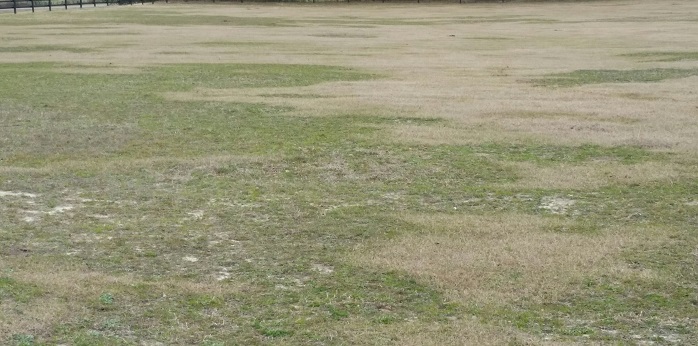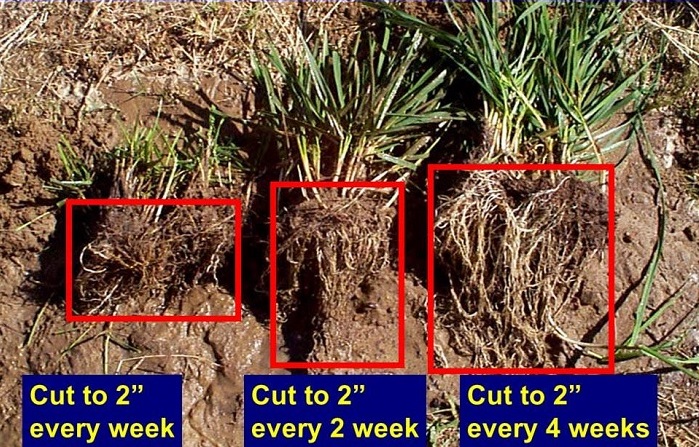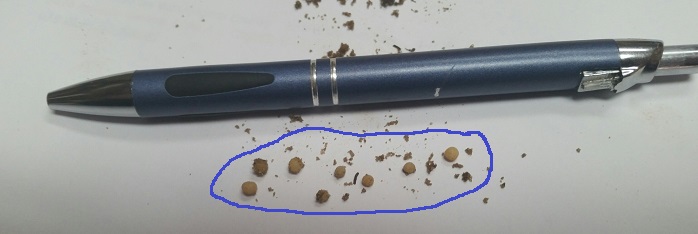
A bahiagrass pasture in Washington County that has experienced significant stand loss. Before any efforts to salvage or replant this pasture can be successful, the factors leading to the decline must be identified and addressed. Photo credit: Mark Mauldin
As an agent I find it somewhat disconcerting when, this time of year, I begin getting questions about replanting perennial grass pastures (bahiagrass, bermudagrass, etc.). By definition, a perennial pasture should last for many years; making replanting a rare exception, not a regular occurrence.
If you find yourself looking at a replanting situation, I would recommend that before you delve into the details of replanting, you take some time to address the question that, in the long run, could have more economic impact than any detail relating to replanting, what happened to your pasture? If you don’t identify and address the cause(s) of the initial stand loss, it is highly likely that replanting will become a common occurrence on your operation – and that is never a good thing.
A few basic principles to help you begin to figure out what happened to your pasture;
- Pasture grasses, like all plants, acquire energy through the process of photosynthesis. This process requires sunlight and takes place in the green tissues of the plant, primarily in the leaves. More leaf area = more photosynthesis = more energy.
- Close, or tight grazing removes the leaves of the grass, thereby severely limiting the plants ability to carry out photosynthesis. No leaves = no photosynthesis = plant must consume energy reserves.
- During the growing season, plants will allocate energy for the production of leaves, at the expense of root growth, to ensure that adequate leaf area is present to enable sufficient photosynthesis.

Continuous removal of leaf tissue will have a detrimental effect on the root system of pasture grass.
Photo credit: http://onpasture.com/2013/04/30/collect-more-sunshine-to-grow-more-grass/

“A photo from a Canadian research station showing the root growth of bunchgrass plants that were kept clipped at certain levels.”
Photo and caption from: http://managingwholes.com/new-topsoil.htm
When pastures are closely grazed for extended periods their root systems begin to decline. This lack of roots makes the plants more susceptible to drought stress and lessens their ability to take up essential nutrients from the soil, making the overall situation worse. Enter a pest or disease at this point and you can see your pasture rapidly descend to a dirt lot.
For the most part, pest and diseases are not major concerns in healthy grazed pastures. This is not because they are not present, but because the rapid growth of otherwise healthy pasture grasses covers any damage that occurs. When pastures are weakened from overgrazing the very same pest or disease can become devastating. Limited roots caused by overgrazing are further damaged by the pest, energy reserves needed for regrowth are already depleted, and plants succumb.

Ground pearls found in a Washington County pasture. Pest like these can be overcome by a healthy pasture, but when weakened by over grazing and inadequate soil fertility they can cause serious problems. Photo credit: Mark Mauldin
Even without a pest or disease accelerating the situation, continuous overgrazing will weaken and eventually kill the plants over time. This happens slowly and often times the desirable species will be replaced by an undesirable species like centipede, which has a growth habit that is much more tolerant of close grazing.
Overgrazing is not the only thing that can weaken a pasture. A lack of available nutrients can greatly inhibit the grass’s ability to grow roots and recover from grazing. Nutrients are constantly being removed from pastures. Nutrients that are taken up by plants are removed by grazing animals (granted some are redeposited as urine and feces but the distribution of these nutrients is generally very poor). Nutrients that are not captured by the plants will move down through the soil and eventually wind up below the root zone. This is especially true of Nitrogen and Potassium, two of the nutrients plants need in the largest amounts.
The extent of the over grazing required to damage a pasture is lessened when a nutrient deficiency is added to the situation. It is important to note that a pasture only needs to be deficient in one nutrient for problems to arise. In other words, simply applying a Nitrogen product will generally not provide all of the nutrients the pasture requires to be healthy.
We have identified some of the common factors that lead to stand decline or failure; overgrazing and failure to maintain adequate soil fertility. After recognizing these factors, the basic steps needed to ensure a long productive life for a pasture are fairly straight forward; practice sound grazing management and supply adequate nutrients.
There are lots of specific grazing strategies that can be very effective. They all are built on two key principles; 1) Do not remove so much leaf area that photosynthesis is severely impaired. A good rule of thumb here is to “take half and leave half.” 2) Allow the plants some “rest time” so they can build up adequate energy reserves. By providing the plants multiple days with no grazing pressure you enable them to recover and grow stronger again, so they are better able to deal with adverse conditions they may encounter.
There is an excellent system in place to help producers know exactly what they need to do in terms of supplying nutrients. Collect soil samples, send them to the Extension Soils Testing Lab, and follow the fertilizer recommendations the lab provides. Your county’s Agriculture Extension Agent will be happy to assist you in this process or to provide you with additional information about any of the topics addressed in this article.
If you take care of your pasture, by utilizing a sound grazing management strategy and supplying adequate nutrients, your pasture will take care of your livestock for a long time. If not, you will get lots of practice replanting pastures and fighting weeds.
- Improve Your Pasture Management this Spring - April 19, 2024
- Plant Now for the Panhandle Watermelon Festival Big Melon Contest & New Junior Jubilee Kid’s Contest - March 8, 2024
- Central Panhandle Pesticide Applicator Training Series – February 12-15 - January 19, 2024
